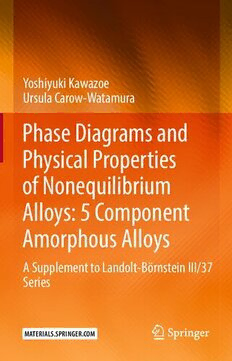
Phase Diagrams and Physical Properties of Nonequilibrium Alloys: 5 Component Amorphous Alloys: A Supplement to Landolt-Börnstein III/37 Series PDF
Preview Phase Diagrams and Physical Properties of Nonequilibrium Alloys: 5 Component Amorphous Alloys: A Supplement to Landolt-Börnstein III/37 Series
Yoshiyuki Kawazoe Ursula Carow-Watamura Phase Diagrams and Physical Properties of Nonequilibrium Alloys: 5 Component Amorphous Alloys A Supplement to Landolt-Börnstein III/37 Series MATERIALS.SPRINGER.COM Phase Diagrams and Physical Properties of Nonequilibrium Alloys: 5 Component Amorphous Alloys (cid:129) Yoshiyuki Kawazoe Ursula Carow-Watamura Phase Diagrams and Physical Properties of Nonequilibrium Alloys: 5 Component Amorphous Alloys o¨ A Supplement to Landolt-B rnstein III/37 Series With432Figuresand305Tables YoshiyukiKawazoe UrsulaCarow-Watamura NewIndustryCreationHatcheryCenter DepartmentofPhysics,Grad.SchoolofScience TohokuUniversity TohokuUniversity Aoba-ku,Sendai,Japan Aoba-ku,Sendai,Japan ISBN978-3-662-64977-0 ISBN978-3-662-64978-7(eBook) https://doi.org/10.1007/978-3-662-64978-7 ©TheEditor(s)(ifapplicable)andTheAuthor(s),underexclusivelicensetoSpringer-VerlagGmbH,DE, partofSpringerNature2022 Thisworkissubjecttocopyright.AllrightsarereservedbythePublisher,whetherthewholeorpartofthe materialisconcerned,specificallytherightsoftranslation,reprinting,reuseofillustrations,recitation, broadcasting,reproductiononmicrofilmsorinanyotherphysicalway,andtransmissionorinformation storageandretrieval,electronicadaptation,computersoftware,orbysimilarordissimilarmethodology nowknownorhereafterdeveloped. Theuseofgeneraldescriptivenames,registerednames,trademarks,servicemarks,etc.inthispublication doesnotimply,evenintheabsenceofaspecificstatement,thatsuchnamesareexemptfromtherelevant protectivelawsandregulationsandthereforefreeforgeneraluse. Thepublisher,theauthors,andtheeditorsaresafetoassumethattheadviceandinformationinthisbook arebelievedtobetrueandaccurateatthedateofpublication.Neitherthepublishernortheauthorsorthe editorsgiveawarranty,expressedorimplied,withrespecttothematerialcontainedhereinorforanyerrors oromissionsthatmayhavebeenmade.Thepublisherremainsneutralwithregardtojurisdictionalclaims inpublishedmapsandinstitutionalaffiliations. ThisSpringerimprintispublishedbytheregisteredcompanySpringer-VerlagGmbH,DEpartofSpringer Nature. Theregisteredcompanyaddressis:HeidelbergerPlatz3,14197Berlin,Germany Preface Naturalglassesareformedinvariousmaterials,forexample,oxidesandpolymers, while commercial metallic alloys have a crystalline structure either after slow or rapid cooling on casting. Metallic glassy alloys were first produced by using sputtering and rapid solidification techniques at very high cooling rates. Many amorphousalloysproduceduntilthelastdecadeofthelastcentury,beingmarginal glass-formers, have been obtained in the shape of melt-spun ribbons or thin films. Laterrod-shapedsamplesover1cmindiameter(calledbulkmetallicglasses,BMG) wereproducedbycastingofthealloys,havinghighglass-formingabilityinavariety ofalloysystemsincludingRare-Earth(RE)metals-,Mg-,Zr-,Ti-,Fe-,Co-,Pd-,Pt-, Au-, Ag-, Cu-, Ni-, and Ca-based system alloys. These amorphous/glassy alloys demonstratehighstrength,goodelasticity,highwear,andcorrosionresistance. Theexistingdataontheglass-formingability(includingchemicalcompositions, criticalsizeoffullyglassy/amorphoussample,theircharacteristictemperatures,etc.) as well as physical and chemical properties of metallic amorphous materials have been collected since the database project AMOR was started in 1993 and are presentedinthedatabase. Thefirstvolumeofthisseries,LBIII/37A,presenting6,450compositionsfrom 351 ternary amorphous alloy systems of fully amorphous, mixtures of amorphous and crystalline as well as crystalline and quasi-crystalline phases in the form of compositiontrianglesandtables,waspublishedin1996. Thesecondvolume,LBIII/37B,asuccessorvolumetoLBIII/37A,accumulating the data on the structural, thermal, mechanical, magnetic, electrical, and optical properties as well as the corrosion behavior of the ternary alloys listed in volumeA,waspublishedin2011.Inaddition,another32ternaryamorphousalloy systems found in the period from 1995 to 2008 were added to volume B updating importantinformationonternaryamorphousalloys. Thethirdvolume,LBIII/37C,focusesonquaternarymetallicamorphousalloys, whichareofgreatinterestforindustrialapplications.Thevolumecoversthegeneral physical structure, as well as thermal, mechanical, magnetic, electrical, and optical properties. The current fourth volume presents the data of five-component metallic amor- phous alloys, including a large number of specimen obtained by adding a fifth component to a quaternary alloy; some were obtained by starting from lower v vi Preface component base alloys, and there are a few examples of so-called high-entropy alloys. Structural data include diffraction profiles, radial distribution functions, coordi- nation numbers, interatomic distances, etc. The methods include X-ray diffraction, small-angle x-ray scattering, small-angle neutron scattering, atom probe field ion microscopy, electron probe micro analysis, EDX, EXAFS, and XANES Spectra as wellasX-rayphotoelectronspectroscopy. Thermal properties include specific heat capacity, Debye temperature, atomic diffusivity, thermal expansion coefficient, glass transition temperature, reduced glasstransitiontemperature,crystallizationtemperature,enthalpyofcrystallization, structural relaxation, supercooled liquid range, melting enthalpy, critical quantities forformationofamorphousphase,andconfigurationentropy. Mechanical properties include stress-strain curves, yield strength and strain values, elastic moduli, hardness, fatigue strength, fracture and critical fracture temperature,aswellaswearresistance,internalfriction,viscosityandmagnetome- chanicalcouplingdata. Magnetic properties include Curie temperature, magnetization curves, coercive force, remanence, permeability, core loss, saturation magnetic moment, magnetic anisotropy, susceptibility, magnetostriction, Mössbauer spectroscopy data, quadru- polesplittingandisomershift,magnetichyperfinefieldandlinesplitting,aswellas magneticresonancespectra,ferromagneticresonance,etc. Electrical properties include electrical resistivity and conductivity, temperature dependenceofresistivity,Halleffectdata,etc. Corrosion data include potentiostatic and potentiodynamic polarization curves andcorrosionrate. We hope that the present volume composed of a collection of five-component metallic amorphous alloy systems contribute both to fundamental researches and industrialapplications. Sendai,Japan Y.Kawazoe December2022 Contents PartI Introduction .............................................. 1 PartII Data Ag-Al-Co-Cu-La ........................................... 17 Ag-Al-Cu-La-Ni ........................................... 23 Ag-Cu-Hf-Ta-Ti ........................................... 29 Al-B-Cu-Ni-Zr ............................................ 35 Al-B-Fe-Nb-Si ............................................. 41 Al-B-Fe-P-Si .............................................. 43 Al-Ce-Fe-Nd-Si ............................................ 47 Al-Co-Cu-Ga-Zr ........................................... 49 Al-Co-Cu-La-Ni ........................................... 52 Al-Co-Cu-Mm-Ni .......................................... 60 Al-Co-Cu-Nd-Ni ........................................... 62 Al-Co-Cu-Ni-Y ............................................ 66 Al-Co-Cu-Ni-Zr ........................................... 74 Al-Co-La-Ni-Y ............................................ 84 Al-Cu-Ir-Ni-Zr ............................................ 86 Al-Cu-La-Ni-Zr ............................................ 88 Al-Cu-Nb-Ni-Zr ........................................... 91 vii viii Contents Al-Cu-Ni-Pd-Zr ............................................ 97 Al-Cu-Ni-Si-Zr ............................................ 99 Al-Cu-Ni-Sn-Zr ............................................ 103 Al-Cu-Ni-Ta-Zr ............................................ 110 Al-Cu-Ni-Ti-Zr ............................................ 114 Al-Cu-Ni-Y-Zr ............................................. 117 Al-Nb-Ni-Ta-Zr ............................................ 119 Al-Nb-Ni-Ti-Zr ............................................ 127 B-C-Co-Cr-Fe ............................................. 132 B-C-Co-Cr-Mo ............................................ 140 B-C-Co-Fe-Pr ............................................. 142 B-C-Cr-Fe-Mo ............................................. 145 B-C-Cr-Fe-Si .............................................. 161 B-C-Dy-Fe-Mo ............................................ 163 B-C-Er-Fe-Mo ............................................. 166 B-C-Fe-Ga-P .............................................. 169 B-C-Fe-Mo-P ............................................. 174 B-C-Fe-P-Si ............................................... 182 B-Co-Cr-Fe-Si ............................................. 193 B-Co-Cu-Fe-Mo ........................................... 197 B-Co-Cu-Fe-Nb ............................................ 208 B-Co-Cu-Nb-Si ............................................ 211 B-Co-Cu-Ni-Zr ............................................ 218 B-Co-Dy-Fe-Nd ............................................ 220 B-Co-Fe-Ge-Ni ............................................ 231 B-Co-Fe-Hf-Nb ............................................ 234 B-Co-Fe-Hf-Ni ............................................ 237 B-Co-Fe-Mn-Nb ........................................... 246 B-Co-Fe-Mn-Si ............................................ 253 B-Co-Fe-Mo-Si ............................................ 256 Contents ix B-Co-Fe-Mo-Ta ............................................ 259 B-Co-Fe-Nb-Ni ............................................ 262 B-Co-Fe-Nb-P ............................................. 268 B-Co-Fe-Nb-Si ............................................ 272 B-Co-Fe-Nb-Y ............................................. 278 B-Co-Fe-Nb-Zr ............................................ 284 B-Co-Fe-Ni-Si ............................................. 306 B-Co-Fe-Ni-Zr ............................................ 309 B-Co-Fe-Pr-Zr ............................................ 328 B-Co-Fe-Si-Zr ............................................. 332 B-Co-Fe-Ta-Zr ............................................ 334 B-Co-Fe-W-Zr ............................................ 340 B-Cu-Fe-Nb-Si ............................................ 347 B-Cu-Ni-Si-Ti ............................................. 374 B-Cu-Ni-Ti-Zr ............................................. 376 Be-Cu-Fe-Nb-Zr ........................................... 379 Be-Cu-Nb-Ni-Zr ........................................... 381 Be-Cu-Ni-Sn-Ti ............................................ 383 Be-Cu-Ni-Ti-Zr ............................................ 388 B-Fe-Ga-Ni-P ............................................. 396 B-Fe-Nb-Si-Y ............................................. 398 B-Fe-Nb-Y-Zr ............................................. 400 B-Fe-Ni-Si-Ta ............................................. 405 C-Cr-Er-Fe-Mo ............................................ 410 C-Cr-Fe-Mo-P ............................................. 413 Co-Cu-Ga-Ni-Zr ........................................... 415 Co-Cu-Hf-Ni-Ti ............................................ 417 Co-Cu-Ni-Ti-Zr ............................................ 419 Co-Cu-Sn-Ti-Zr ........................................... 422 Co-Nb-Ni-Sn-Zr ........................................... 424 x Contents Co-Nb-Ni-Ti-Zr ............................................ 430 Cu-Fe-Ni-Ti-Zr ............................................ 435 Cu-Hf-Nb-Ni-Ti ........................................... 440 Cu-Hf-Ni-Ti-Zr ............................................ 447 Cu-Nb-Ni-Si-Ti ............................................ 449 Cu-Ni-P-Ti-Zr ............................................. 452 Cu-Ni-Si-Ti-Zr ............................................ 455 Cu-Pd-Si-Ti-Zr ............................................ 468 Cu-Pd-Sn-Ti-Zr ........................................... 475 Cu-Pd-Ta-Ti-Zr ........................................... 488 Nb-Ni-Ta-Ti-Zr ............................................ 492
